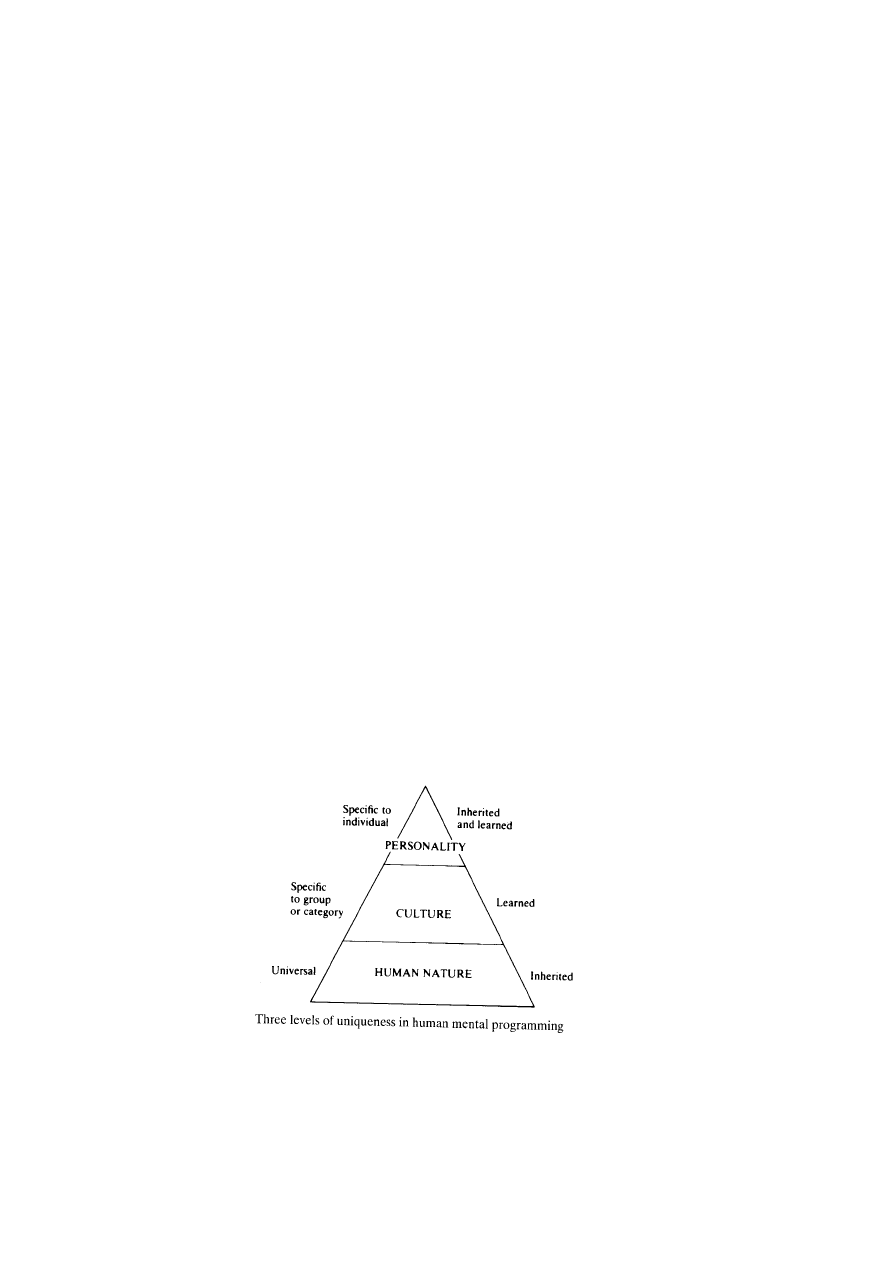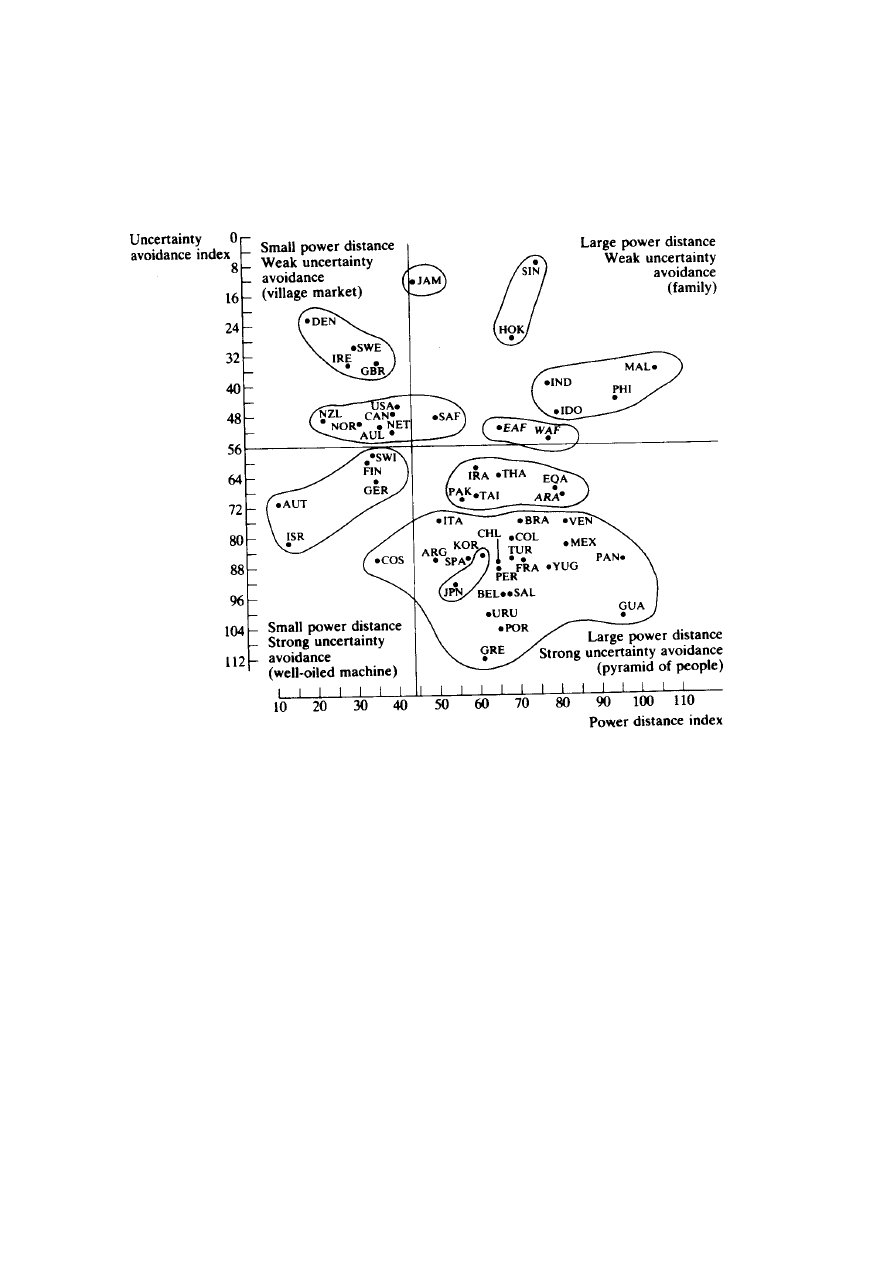
1
HOFSTEDE: Cultures And Organizations - Software of the Mind
Culture as mental programming
In Western languages 'culture' commonly means 'civilization' or 'refinement of the mind' and in particular the
results of such refinement, like education, art, and literature. This is 'culture in the narrow sense; 'culture one'
Culture as mental software, however, corresponds to a much broader use of the word which is common among
social anthropologists: this is ‘culture two’.
In social anthropology, 'culture' is a catchword for all those patterns of thinking, feeling, and acting referred to
in the previous paragraphs. Not only those activities supposed to refine the mind are included in 'culture two', but
also the ordinary and menial things in life: greeting, eating, showing or not showing feelings, keeping a certain
physical distance from others, making love, or maintaining body hygiene.
CULTURE
It is the collective programming of the mind which distinguishes
the members of one group or category of people from another.
It is a collective phenomenon, because it is at least partly shared with people who live or lived within the same
social environment, which is where it was learned.
Culture is learned, not inherited. It derives from one's social environment, not from one's genes.
Culture should be distinguished from human nature on one side, and from an individual's personality on the
other:

2
Cultural relativism
there are no scientific standards for considering one group as intrinsically superior or inferior to another.
'Cultural relativism affirms that one culture has no absolute criteria for judging the activities of another culture as
"low" or "noble".
Symbols, heroes, rituals, and values
Cultural differences manifest themselves in several ways - symbols, heroes, rituals, and values.
The ‘onion diagram’:
Manifestations of culture at different
levels of depth
Symbols are words, gestures, pictures or objects that carry a particular meaning which is only recognized by
those who share the culture. The words in a language or jargon belong to this category, as do dress, hairstyles,
Coca-Cola, flags. New symbols are easily developed and old ones disappear.
Heroes are persons, alive or dead, real or imaginary, who possess characteristics which are highly prized in a
culture, and who thus serve as models for behavior. Snoopy in the USA, Asterix in France.
Rituals are collective activities, technically superfluous in reaching desired ends, but which, within a culture, are
considered as socially essential: they are therefore carried out for their own sake. Ways of greeting and paying
respect to others, social and religious ceremonies are examples.
Symbols, heroes, rituals can be subsumed under the term practices.
The core of culture is formed by values. Values are broad tendencies to prefer certain states of affairs over
others. Values are feelings with an arrow to it: they have a plus and a minus side.
They deal with:
evil vs. good
dirty vs. clean
ugly vs. beautiful
unnatural vs. natural
abnormal vs. normal
paradoxical vs. logical
irrational vs. rational

3
Values are among the first things children learn - not consciously, but implicitly.
Development psychologists believe that by the age of 10, most children have their basic value system firmly in
place, and after that age, changes are difficult to make.
Because they were acquired so early in our lives, many values remain unconscious to those who hold them.
Therefore they cannot be discussed, nor can they be directly observed by outsiders. They can only be inferred
from the way people act under various circumstances.
Layers of culture
As almost everyone belongs to a number of different groups and categories of people at the same time, people
unavoidably carry several layers of mental programming within themselves, corresponding to different levels of
culture. For example:
• a national level according to one's country ( or countries for people who migrated
during their lifetime);
• a regional and/or ethnic and/or religious and/or linguistic affiliation level, as most
nations are composed of culturally different regions and/ or ethnic and/or religious
and/or language groups;
• a gender level, according to whether a person was born as a girl or as a boy;
• a generation level, which separates grandparents from parents from children;
• a social class level, associated with educational opportunities and with a person's
occupation or profession;
• for those who are employed, an organizational or corporate level according to the
way employees have been socialized by their work organization.
National culture differences
“invention” of nations is recent ... nation is not the same as society formation of countries in Africa ...
But forces push towards integration, - dominant language, common mass media, national army, ...
Danger in thinking of “typically German” or “French” - just a matter of expediency
DIMENSIONS OF NATIONAL CULTURES
Social anthropology
In the first half of the twentieth century, social anthropology has developed the conviction that all societies,
modern or traditional, face the same basic problems; only the answers differ. For some researchers the following
issues qualify as common basic problems worldwide, with consequences for the functioning of societies, of
groups within those societies, and of individuals within those groups:
1. Relation to authority
2. Conception of self, in particular:
a. the relationship between individual and society, and
b. the individual's concept of masculinity and femininity
3. Ways of dealing with conflicts, including the control of aggression and the expression of feelings.

4
Hofstede
- survey data about the values of people in over 50 countries around the world. These people worked in the local
subsidiaries of one large multinational corporation – IBM.
A statistical analysis of the answers on questions about the values of similar IBM employees in different
countries revealed common problems, but with solutions differing from country to country, in the following
areas:
1. Social inequality, including the relationship with authority;
2. The relationship between the individual and the group;
3. Concepts of masculinity and femininity: the social implications of having been born as a boy or a girl;
4. Ways of dealing with uncertainty, relating to the control of aggression and the expression of emotions.
The four basic problem areas represent dimensions of cultures. A dimension is an aspect of a culture that can be
measured relative to other cultures.
The basic problem areas correspond to dimensions which Hofstede named as
power distance (from small to large ),
collectivism versus individualism,
femininity versus masculinity, and
uncertainty avoidance (from weak to strong).
Each of these terms existed already in some part of the social sciences, and they seemed to apply reasonably well
to the basic problem area each dimension stands for.
Together they form a four-dimensional (4-D) model of differences among national cultures.
Each country in this model is characterized by a score on each of the four dimensions.
More recently, a fifth dimension of differences among national cultures was identified, opposing a long-term
orientation in life to a short-term orientation
(Cultural differences exist also according to region, religion, gender, generation, and class)
(Organizational or corporate cultures)

5
Dimensions of national cultures
Power distance can be defined as the extent to which the less powerful members of institutions and
organizations within a country expect and accept that power is distributed unequally.
'Institutions' are the basic elements of society like the family, school, and the community; 'organizations' are the
places where people work.
Individualism pertains to societies in which the ties between individuals are loose: everyone is
expected to look after himself or herself and his or her immediate family. Collectivism as its opposite
pertains to societies in which people from birth onwards are integrated into strong, cohesive ingroups,
which throughout people's lifetime continue to protect them in exchange for unquestioning loyalty.
Masculinity indicates the extent to which the dominant values of a society are "masculine" (e.g.,
assertive and competitive). Masculinity pertains to societies in which social gender roles are clearly
distinct (i.e., men are supposed to be assertive, tough, and focused on material success whereas
women are supposed to be more modest, tender, and concerned with the quality of life. Femininity
pertains to societies in which social gender roles overlap i.e., both men and women are supposed to be
modest, tender, and concerned with the quality of life.
Uncertainty avoidance can be defined as the extent to which the members of a culture feel threatened
by uncertain or unknown situations and try to avoid such situations. This feeling is, among other
things, expressed through nervous stress and in a need for predictability: a need for written and
unwritten rules.
Added later:
Confucian dynamism or long-term vs. short-term orientation in life
On the pole which could be labeled 'Long-term orientation' :
persistence (perseverance )
ordering relationships by status and observing this order
thrift
having a sense of shame
On the opposite pole 'Short-term orientation':
personal steadiness and stability
protecting your 'face'
Respect for tradition
reciprocation of greetings, favors, and gifts
In each dimension, differences among countries manifest themselves at different levels:
Child/family – School – workplace – citizen/state – ideas/philosophy

6
POWER DISTANCE
Power distance index (PDI) values for 50 countries and 3 regions
Score
rank
Country or
region
PDI
score
Score
rank
Country or
region
PDI
score
1 Malaysia 104
27/28
South
Korea 60
2/3 Guatemala 95 29/30
Iran
58
2/3 Panama
95 29/30
Taiwan
58
4 Philippines 94 31 Spain
57
5/6 Mexico
81 32 Pakistan
55
5/6 Venezuela
81 33 Japan
54
7 Arab
countries
80 34 Italy
50
8/9 Equador
78 35/36
Argentina
49
8/9 Indonesia
78 35/36
South
Africa
49
10/11 India
77
37
Jamaica
45
10/11 West
Africa
77
38
USA
40
12 Yugoslavia 76 39 Canada
39
13 Singapore 74 40 Netherlands
38
14 Brazil
69 41 Australia
36
15/16 France
68
42/44 Costa
Rica
35
15/16 Hong
Kong
68
42/44 Germany
35
17 Colombia
67 42/44
Great
Britain
35
18/19 Salvador
66
45
Switzerland
34
18/19 Turkey
66
46
Finland
33
20 Belgium
65 47/48
Norway
31
21/23 East
Africa
64
47/48 Sweden
31
21/23 Peru
64
49
Ireland
(Republic) 28
21/23 Thailand
64
50
New
Zealand
22
24/25 Chile
63
51
Denmark
18
24/25 Portugal
63
52
Israel
13
26 Uruguay
61 53 Austria
11
27/28 Greece
60

7
POWER DISTANCE
Key Differences between small and large power distance societies.
I: general norm, family, school, and workplace
Small power distance
Large power distance
1.
Inequalities among people should be
minimized
Inequalities among people are both expected
and desired
2.
There should be, and there is to some extent,
interdependence between less and more
powerful people
Less powerful people should be dependent
on the more powerful; in practice, less
powerful people are polarized between
dependence and counterdependence
3.
Parents treat children as equals
Parents teach children obedience
4.
Children treat parents as equals
Children treat parents with respect
5.
Teachers expect initiatives from students in
class
Teachers are expected to take all initiatives
in class
6.
Teachers are experts who transfer
impersonal truths
Teachers are gurus who transfer personal
wisdom
7.
Students treat teachers as equals
Students treat teachers with respect
8.
More educated persons hold less
authoritarian values than less educated
persons
Both more and less educated persons show
almost equally authoritarian values
9.
Hierarchy in organizations means an
inequality of roles, established for
convenience
Hierarchy in organizations reflects the
existential inequality between higher- ups
and lower-downs
10.
Decentralization is popular
Centralization is popular
11.
Narrow salary range between top and bottom
of organization
Wide salary range between top and bottom
of organization
12.
Subordinates expect to be consulted
Subordinates expect to be told what to do
13.
The ideal boss is a resourceful democrat
The ideal boss is a benevolent autocrat or
good father
14.
Privileges and status symbols are frowned
upon
Privileges and status symbols for managers
are both expected and popular

8
POWER DISTANCE
Key differences between small and large power distance societies
II: politics and ideas.
Small power distance
Large power distance
1. The use of power should be legitimate and is
subject to criteria of good and evil
Might prevails over right: whoever holds the
power is right and good
2. Skills, wealth, power, and status need not go
together
Skills, wealth, power, and status should go
together
3. The middle class is large
The middle class is small
4. All should have equal rights
The powerful have privileges
5. Powerful people try to look less powerful
than they are
Powerful people try to look as impressive as
possible
6. Power is based on formal position, expertise,
and ability to give rewards
Power is based on family or friends,
charisma, and ability to use force
7. The way to change a political system is by
changing the rules (evolution)
The way to change a political system is by
changing the people at the top (revolution)
8. The use of violence in domestic politics is
rare
Domestic political conflicts frequently lead
to violence
9. Pluralist governments based on outcome of
majority votes
Autocratic or oligarchic governments based
on cooptation
10. Political spectrum shows strong center and
weak right and left wings
Political spectrum, if aJlowed to be
manifested, shows weak center and strong
wings
11. Small income differentials in society, further
reduced by the tax system
Large income differentials in society, further
increased by the tax system
12. Prevailing religions and philosophical
systems stress equality
Prevailing religions and philosophical
systems stress hierarchy and stratification
13. Prevailing political ideologies stress and
practice power sharing
Prevailing political ideologies stress and
practice power struggle
14. Native management theories focus on role of
employees
Native management theories focus on role of
managers

9
INDIVIDUALISM
Individualism index (IDV) values for 50 countries and 3 regions
Score
rank
Country or region IDV
score
Score
rank
Country or
region
IDV
score
1 USA
91
28 Turkey
37
2 Australia
90
29 Uruguay 36
3 Great
Britain 89
30 Greece
35
4/5 Canada
80
31 Philippines 32
4/5 Netherlands
80
32 Mexico
30
6
New Zealand
79
33/35
East Africa
27
7 Italy
76
33/35
Yugoslavia 27
8 Belgium
75
33/35
Portugal 27
9 Denmark
74
36 Malaysia 26
10/11 Sweden
71
37
Hong
Kong 25
10/11 France
71
38
Chile
23
12
Ireland (Rep)
70
39/41
West Africa
20
13 Norway
69
39/41
Singapore 20
14 Switzerland 68
39/41
Thailand 20
15 Germany
F.R.
67
42 Salvador 19
16 South
Africa 65
43 South
Korea
18
17 Finland
63
44 Taiwan
17
18 Austria
55
45 Peru
16
19 Israel
54
46 Costa
Rica 15
20 Spain
51
47/48
Pakistan 14
21 India
48
47/48
Indonesia 14
22/23 Japan
46
49
Colombia
13
22/23 Argentina
46
50
Venezuela
12
24 Iran
41
51 Panama
11
25 Jamaica
39
52 Equador 8
26/27 Brazil
38
53
Guatemala
6
26/27 Arab
countries 38

10
INDIVIDUALISM
Key differences between collectivist and individualist societies.
I: general norm, family, school, and workplace
Collectivist Individualist
1. People are born into extended families or
other ingroups which continue to protect
them in exchange for loyalty
Everyone grows up to look after him/ herself
and his/her immediate (nuclear) family only
2. Identity is based in the social network to
which one belongs
Identity is based in the individual
3. Children learn to think in terms of 'we'
Children learn to think in terms of 'I'
4. Harmony should always be maintained and
direct confrontations avoided
Speaking one's mind is a characteristic of an
honest person
5. High-context communication
Low-context communication
6. Trespassing leads to shame and loss of
face for self and group
Trespassing leads to guilt and loss of self-
respect
7. Purpose of education is learning how to do Purpose of education is learning how to
learn
8. Diplomas provide entry to higher status
groups
Diplomas increase economic worth and/or
self-respect
9. Relationship employer-employee is
perceived in moral terms, like a family link
Relationship employer-employee is a
contract supposed to be based on mutual
advantage
10. Hiring and promotion decisions take
employees' ingroup into account
Hiring and promotion decisions are
supposed to be based on skills and rules only
11. Management is management of groups
Management is management of individuals
12. Relationship prevails over task
Task prevails over relationship

11
INDIVIDUALISM
Key differences between collectivist and individualist societies.
II: politics and ideas
Collectivist Individualist
1. Collective interests prevail over
individual interests
Individual interests prevail over
collective interests
2. Private life is invaded by group(s)
Everyone has a right to privacy
3. Opinions are predetermined by group
membership
Everyone is expected to have a private
opinion
4. Laws and rights differ by group
Laws and rights are supposed to be the
same for all
5. Low per capita GNP
High per capita GNP
6. Dominant role of the state in the
economic system
Restrained role of the state in the
economic system
7. Economy based on collective interests
Political power exercised by interest
groups
Economy based on individual interests
Political power exercised by voters
8. Press controlled by the state
Press freedom
9. Imported economic theories largely
irrelevant because unable to deal with
collective and particularist interests
Native economic theories based on
pursuit of individual self-interests
10. Ideologies of equality prevail over
ideologies of individual freedom
Ideologies of individual freedom prevail
over ideologies of equality
11. Harmony and consensus in society are
ultimate goals
Self-actualization by every individual is
an ultimate goal

12
FEMINISM
Masculinity index (MAS) values for 50 countries and 3 regions
Score
rank
Country or
region
MAS
score
Score
rank
Country or
region
MAS
score
1 Japan
95
28 Singapore
48
2 Austria
79
29
Israel
47
3 Venezuela
73
30/31 Indonesia
46
4/5 Italy
70
30/31 West
Africa
46
4/5 Switzerland
70
32/33 Turkey
45
6 Mexico
69
32/33 Taiwan
45
7/8 Ireland
68
34
Panama
44
(Republic
of)
35/36
Iran
43
7/8 Jamaica
68
35/36 France
43
9/10 Great
Britain
66
37/38
Spain
42
9/10 Germany
FR
66
37/38
Peru
42
11/12 Philippines
64
39
East
Africa
41
11/12 Colombia
64
40
Salvador
40
13/14
South Africa
63
41
South Korea
39
13/14 Equador
63
42
Uruguay
38
15 USA
62
43
Guatemala
37
16 Australia
61
44
Thailand
34
17 New
Zealand
58
45
Portugal
31
18/19 Greece
57
46
Chile
28
18/19 Hong
Kong
57
47
Finland
26
20/21 Argentina
56
48/49
Yugoslavia
21
20/21 India
56
48/49
Costa
Rica
21
22 Belgium
54
50
Denmark
16
23 Arab
countries
53
51
Netherlands
14
24 Canada
52
52
Norway
8
25/26 Malaysia
50
53
Sweden
5
25/26 Pakistan
50
27 Brazil
49

13
FEMINISM
Key differences between feminine and masculine societies.
I: general norm, family, school, and workplace
Feminine
Masculine
1. Dominant values in society are
caring for others and preservation
Dominant values in society are material
success and progress
2. People and warm relationships are important
Money and things are important
3. Everybody is supposed to be modest
Men are supposed to be assertive,
ambitious, and tough
4. Both men and women are allowed to be tender
and to be concerned with relationships
Women are supposed to be tender and to
take care of relationships
5. In the family, both fathers and mothers deal
with facts and feelings
In the family, fathers deal with facts and
mothers with feelings
6. Both boys and girls are allowed to cry but
neither should fight
Girls cry, boys don't; boys should fight
back when attacked, girls shouldn't fight
7. Sympathy for the weak
Sympathy for the strong
8. Average student is the norm
Best student is the norm
9. Failing in school is a minor accident
Failing in school is a disaster
10. Friendliness in teachers appreciated
Brilliance in teachers appreciated
11. Boys and girls study same subjects
Boys and girls study different subjects
12. Work in order to live
Live in order to work
13. Managers use intuition and strive for consensus
Managers expected to be decisive and
assertive
14. Stress on equality, solidarity, and quality of
work life
Stress on equity, competition among
colleagues, and performance
15. Resolution of conflicts by compromise and
negotiation
Resolution of conflicts by fighting them
out

14
FEMINISM
Key differences between feminine and masculine societies.
II: politics and ideas
Feminine
Masculine
1. Welfare society ideal
Performance society ideal
2. The needy should be helped
The strong should be supported
3. Permissive society
Corrective society
4. Small and slow are beautiful
Big and fast are beautiful
5. Preservation of the environment
should have highest priority
Maintenance of economic growth should have
highest priority
6. Government spends relatively large
proportion of budget on
development assistance to poor
countries
Government spends relatively small proportion of
budget on development assistance to poor
countries
7. Government spends relatively small
proportion of budget on armaments
Government spends relatively large proportion of
budget on armaments
8. International conflicts should be
resolved by negotiation and
compromise
International conflicts should be resolved by a
show of strength or by fighting
9. A relatively large number of women
in elected political positions
A relatively small number of women in elected
political positions
10. Dominant religions stress the
complementarity of the sexes
Dominant religions stress the male prerogative
11. Women's liberation means that men
and women should take equal shares
both at home and at work
Women's liberation means that women will be
admitted to positions hitherto only occupied by
men

15
Score
rank
Country or
region
UAI
score
Score rank
Country or region
UAI
score
1 Greece
112
28
Equador
67
2 Portugal
104
29
Germany
FR
65
3 Guatemala
101
30
Thailand
64
4 Uruguay
100
31/32 Iran
59
5/6 Belgium
94
31/32
Finland
59
5/6 Salvador
94
33
Switzerland
58
7 Japan
92
34
West
Africa
54
8 Yugoslavia
88
35
Netherlands
53
9 Peru
87
36
East
Africa
52
10/15 France
86
37
Australia
51
10/15 Chile
86
38
Norway
50
10/15 Spain
86
39/40
South
Africa
49
10/15 Costa Rica
86
39/40
New Zealand
49
10/15 Panama
86
41/42
Indonesia
48
10/15 Argentina
86
41/42
Canada
48
16/17 Turkey
85
43
USA
46
16/17 South
Korea
85
44
Philippines
44
18 Mexico
82
45
India
40
19 Israel
81
46
Malaysia
36
20 Colombia
80
47/48
Great
Britain
35
21/22 Venezuela
76
47/48
Ireland (Republic of)
35
21/22 Brazil
76
49/50
Hong
Kong
29
23 Italy
75
49/50
Sweden
29
24/25 Pakistan
70
51
Denmark
23
24/25 Austria
70
52
Jamaica
13
26 Taiwan
69
53
Singapore
8
27 Arab
countries
68
UNCERTAINTY
Uncertainty avoidance index (UAI) values for 50 countries and 3 regions

16
UNCERTAINTY
Key differences between weak and strong uncertainty avoidance societies.
I: general norm, family, school, and workplace
Weak uncertainty avoidance
Strong uncertainty avoidance
1. Uncertainty is a normal feature of life
and each day is accepted as it comes
The uncertainty inherent in life is felt as a
continuous threat which must be fought
2. Low stress; subjective feeling of
wellbeing
High stress; subjective feeling of anxiety
3. Aggression and emotions should not
be shown
Aggression and emotions may at proper times
and places be ventilated
4. Comfortable in ambiguous situations
and with unfamiliar risks
Acceptance of familiar risks; fear of ambiguous
situations and of unfamiliar risks
5. Lenient rules for children on what is
dirty and taboo
Tight rules for children on what is dirty and taboo
6. What is different, is curious
What is different, is dangerous
7. Students comfortable with open-
ended learning situations and
concerned with good discussions
Students comfortable in structured learning
situations and concerned with the right answers
8. Teachers may say 'I don't know'
Teachers supposed to have all the answers
9. There should not be more rules than
is strictly necessary
Emotional need for rules, even if these will never
work
10. Time is a framework for orientation Time is money
11. Comfortable feeling when lazy; hard-
working only when needed
Emotional need to be busy; inner urge to work
hard
12. Precision and punctuality have to be
learned
Precision and punctuality come naturally
13. Tolerance of deviant and innovative
ideas and behavior
Suppression of deviant ideas and behavior;
resistance to innovation
14. Motivation by achievement and
esteem or belongingness
Motivation by security and esteem or
belongingness

17
UNCERTAINTY
Key differences between weak and strong uncertainty avoidance societies.
II: politics and ideas
1.
Few and general laws and rules
Many and precise laws and rules
2.
If rules cannot be respected, they
should be changed
If rules cannot be respected, we are sinners
and should repent
3.
Citizen competence versus
authorities
Citizen incompetence versus authorities
4.
Citizen protest acceptable
Citizen protest should be repressed
5.
Citizens positive towards
institutions
Citizens negative towards institutions
6.
Civil servants positive towards
political process
Civil servants negative towards political
process
7.
Tolerance, moderation
Conservatism, extremism, law and order
8.
Positive attitudes towards young
people
Negative attitudes towards young people
9.
Regionalism, internationalism,
attempts at integration of minorities
Nationalism, xenophobia, repression of
minorities
10.
Belief in generalists and common
sense
Belief in experts and specialization
11.
Many nurses, few doctors
Many doctors, few nurses
12.
One group's truth should not be
imposed on others
There is only one Truth and we have it
13.
Human rights: nobody should be
persecuted for their beliefs
Religious, political, and ideological
fundamentalism and intolerance
14.
In philosophy and science, tendency
towards relativism and empiricism
In philosophy and science, tendency
towards grand theories
15.
Scientific opponents can be personal
friends
Scientific opponents cannot be personal
friends
Weak uncertainty avoidance
Strong uncertainty avoidance

18
Index Scores and Ranks for Countries and Regions From the IBM Set
Source: Hofstede(2001:500)
Power Uncertainty
Individualism/
Masculinity/
Long/Short-
Term
Distance Avoidance
Collectivism
Femininity Orientation
Country
Index Rank Index Rank Index Rank Index Rank Index Rank
Argentina
49 35-36 86 10-15 46 22-23 56 20-21
Australia
36
41
51
37
90
2
61
16
31
22-24
Austria
11
53
70
24-25
55
18
79
2
31a
22-24
Belgium
65
20
94
5-6
75
8
54
22
38a
18
Brazil
69
14
76
21-22
38
26-27
49
27
65
6
Canada
39
39
48
41-42
80
4-5
52
24
23
30
Chile
63
24-25 86
10-15 23 38 28 46
Colombia
67 17
80 20 13 49 64
11-12
Costa Rica
35 42-44 86 10-15 15 46
21 48-49
Denmark
18
51 23
51 74 9 16
50
46a
10
Ecuador
78 8-9 67 28
8 52
63
13-14
Finland
33
46
59
31-32
63
17
26
47
41a
14
France
68 15-16 86 10-15 71 10-11 43 35-36
39a 17
Germany
35
42-44
65
29 67
15 66
9-10
31
22-24
Great Britain
35
42-44
35
47-48
89
3
66
9-10
25
28-29
Greece
60 27-28 112
1
35 30
57 18-19
Guatemala
95 2-3 101
3
6 53 37 43
Hong Kong
68 15-16 29 49-50 25 37
57 18-19 96
2
Indonesia
78 8-9
48 41-42 14 47-48 46 30-31
India
77 10-11 40 45
48 21
56 20-21 61
7
Iran
58 29-30 59 31-32 41 24
43 35-36
Ireland
28
49
35
47-48
70
12
68
7-8
43a
13
Israel
13 52 81 19 54 19 47 29
Italy
50
34 75
23 76 7 70
4-5
34a
19
Jamaica
45 37
13 52 39 25 68 7-8
Japan
54
33
92
7
46
22-23
95
1
80
4
Korea (South)
60 27-28 85 16-17 18 43
39
41 75
5
Malaysia
104
1
36
46
26
36
50
25-26
Mexico
81
5-6
82
18
30
32
69
6
Netherlands
38 40
53 35 80 4-5 14 51 44 11-12
Norway
31
47-48 50 38 69 13
8 52
44a
11-12
New Zealand
22
50
49
39-40
79
6
58
17
30
25-26
Pakistan
55 32
70 24-25 14 47-48 50 25-26
0
34
Panama
95 2-3 86
10-15 11 51 44 34
Peru
64
21-23
87
9
16
45
42
37-38
Philippines
94
4
44
44
32
31
64
11-12
19
31-32
Portugal
63
24-25
104
2
27
33-35
31
45
30a
25-26
South Africa
49 35-36 49 39-40 65 16
63 13-14
Salvador
66
18-19 94 5-6 19 42 40 40
Singapore
74 13
8 53 20
39-41 48 28 48 9
Spain
57 31
86
10-15 51 20 42
37-38 19a
31-32
Sweden
31 47-48 29 49-50 71 10-11
5 53
33
20
Switzerland
34 45
58 33 68 14 70 4-5 40a
15-16
Taiwan
58 29-30
69 26
17 44
45 32-33 87
3
Thailand
64 21-23
64 30
20 39-41 34 44
56
8
Turkey
66 18-19
85 16-17 37 28
45 32-33
Uruguay
61
26
100
4
36
29
38
42
United States
40
38
46
43
91
1
62
15
29
27
Venezuela
81
5-6
76
21-22
12
50
73
3
Yugoslavia
76
12
88
8
27
33-35
21
48-49
Regions:
Arab countries
80
7
68
27
38
26-27
53
23
East Africa
64 21-23
52 36
27 33-35 41 39
25 28-29
West Africa
77 10-11 54 34
20 39-41 46 30-31 16
33
NOTE. 1 = highest rank. LTO ranks. 1 = China; 15-16 = Bangladesh; 21 = Poland; 34 = lowest
a - Based on EMS consumer survey.

19
Index Scores by Language Area for Multilingual Countries
Source: Hofstede(2001:501)
Country and Part
Power
Distance
Index
Uncertainty
Avoidance
Index
Individualism
Index
Masculinity
Index
Long-Term
Orientation
Index
Belgium total
a
65 94
75
54
Dutch speakers
a
61 97 78 43
French speakers
a
67
93 72 60
Switzerland total
a
34 58
68
70
German speakers
a, c
26
56
69
72
French speakersa
70
70
64
58
Yugoslavia total
a
76 88
27
21
Croatia (Zagreb)
b
73
80 33 40
Serbia (Beograd)
b
86
92 25 43
Slovenia (Ljubljana)
b
71
88
27
19
Canada total
a
39 48
80
52 23
French speakers
d
54
60 73 45 30
Australia total
a
36
51
90
61
31
Aborigines
e
80 128 89 22 -10
a Based on IBM survey data,
b Based on reanalysis of IBM survey data (Hofstede, 1993)
c See also Kopper (1993),
d Based on my interpretation of Rokeach Value Survey scores collected by McCarrey, Edwards, and Jones
(1978); of work goal importance scores collected by Jain, Normand, and Kanungo (1979); IDV based on
regression from data collected by Lambert and Klineberg (1967); and observations by Dr Christoph Barmeyer
(personal communication, 1999)
e. Based on observations of Dr. Ray Simonsen, Victoria University, Darwin (personal communication, 1998)

20
Index Score Estimates for Countries Not in the IBM Set
Source: Hofstede(2001:502)
Power
Distance
Uncertainty Individualism Masculinity
Long-Term
Country and
Part
Index
Avoidance
Index
Index Index
Orientation
Index
Bangladesh 80 60 20 55 40
Bulgaria 70
85
30
40
China 80
30
20
66
118
Czechia 57
74
58
57
13
Estonia 40
60
60
30
Hungary 46
82
80
88
50
Luxembourg 40 70 60 50
Malta 56
96
59
47
Morocco 70
68
46
53
Poland 68
93
60
64
32
Romania 90
90
30
42
Russia 93
95
39
36
Slovakia 104
51
52
110
38
Surinam 85
92
47
37
Trinidad 47
55
16
58
Vietnam 70
30
20
40
80
SOURCES. Bangladesh: LTO, see Chapter 7; other dimensions based on descriptive information. Bulgaria:
based on observation and descriptive information. China: MAS, see Hofstede (1996b); LTO, see Chapter 7;
other dimensions based on observation and an extensive literature (see Chapters 3,4, 5, and 7). Czechia:
Kruzela ( 1995), Thorpe and Pavlica ( 1996), and Kolman, Hofstede, Noorderhaven, and Dienes (1999). Eslonia
MAS, Hofstede, Kolman, Nicolescu, and Pajumaa (1996); other dimensions, observation. Hungary: Varga
(1986) and Kolman et al (1999). Luxembourg: observation and clustering in European Union data. Malla:
Hoppe (1990). Morocco: POI and IDV from Helmreich and Merritt ( 1998); other dimensions, Arabic-speaking
countries scores Poland: Nasierowski and Mikula ( 1998) and Kolman et aI (1999). Romania: MAS, Hofstede et
al (1996); other dimensions, observation, and descriptive data. Russia: MAS, Hofstedeet al. (1996); other
dimensions, raw data from unpublished studies by Bollinger(1988) and Bradley (1998), observation and
descriptive data. Slovakia: Kolman et al (1999) Surinam: Nanhekhan (1990). Trinidad: Punnett, Singh, and
Williams (1994) Vielnam: observation and descriptive information.

21
In the area of organizations and management, theories, models and techniques developed
in a given country – usually in the United States – are not valid and ready to be applied,
without further considerations, in countries with very different cultures.
EXAMPLES:
MbO
Mexico is characterised by a very high level of “power distance”, the United States by a very low
one (scores from 81 to 40, respectively, or, among 53 countries, the fifth place for Mexico and 38th
for United States). As a result of this gap it is only to be expected that a management technique
such as “Management by Objectives”, popular in the United States, may be inappropriate in
Mexico – the Mexican managers would not accept delegating important tasks to their subordinates
and these, in turn, due to their weak sense for egalitarianism , would not feel comfortable with a
model of participative characteristics
Matrix structures
Matrix structures were seen a few years ago as combining the advantages of structures by product,
geography and function. Decentralized decision processes, overlapping responsibilities and
multiple channels of information permitted dealing better with external complexity, overcoming
the internal tensions and responding more rapidly and more flexibly to new challenges. Although
overall the matrix structure never experienced the success that had been anticipated, in countries
like Germany and France it encountered special difficulties.In France this was because the matrix
structure violates the principle of unity of command and hierarchical line. In Germany it was
because it goes against the absolute need for clear structures, information channels, roles and
responsibilities.This rejection could be explained by the high levels of power distance in France
and of large uncertainty avoidance in Germany
Maslow’s hierarchy of needs.
Maslow defended the existence of five basic human
needs, forming a hierarchy comprising physiological, safety, social nature, esteem and self-
actualisation needs. Those of a higher level are active and may be motivating, when the inferior
ones are satisfied.
What Maslow thought were universal needs of any human being, and what is taught in
management manuals, proved in reality to be valid only for the North Americans and some nations
of similar cultural characteristics.In countries of high uncertainty avoidance, safety needs may be
much more important than Maslow thought, the job for the whole life is more important than
having a more interesting and challenging position.In countries with a low level of masculinity,
social needs will tend to be more important, the same holding in less individualist countries (more
collective).

22
Culture and international competition:
competitive advantages of different cultural profiles
Power distance small:
acceptance of responsibility
Power distance large:
discipline
Individualism:
management mobility
Collectivism: employee
commitment
Masculinity:
mass production; efficiency;
heavy industry, bulk chemistry
Femininity:
personal service; custom-made products;
agriculture,
biochemistry
Uncertainty avoidance weak:
basic innovations
Uncertainty avoidance strong:
precision
Hofstede: Cultures and Organizations, p.240

23
Somewhere in Western Europe a middle-sized textile printing company struggled for survival.
Cloth, usually imported from Asian countries, was printed in multicolored patterns according to the
desires of customers, firms producing fashion clothing for the local market. The company was run
by a general manager to whom three functional managers reported: one for design and sales, one
for manufacturing, and one for finance and personnel. The total work force numbered about 250.
The working climate in the firm was often disturbed by conflicts between the sales and
manufacturing managers. The manufacturing manager had an interest, as manufacturing managers
have the world over, in smooth production and in minimizing product changes. He preferred
grouping customer orders into large batches. Changing color and/or design implied cleaning the
machines which took productive time away and also wasted costly dyestuffs. The worst was
changing from a dark color set to a light one, because every bit of dark-colored dye left would
show on the cloth and spoil the product quality. Therefore the manufacturing planners tried to start
on a clean machine with the lightest shades and gradually move towards darker ones, postponing
the need for an overall cleaning round as long as possible.
The design and sales manager tried to satisfy his customers in a highly competitive market. These
customers, fashion clothing firms, were notorious for short-term planning changes. As their
supplier, the printing company often received requests for rush orders. Even when these orders
were small and unlikely to be profitable the sales manager hated to say 'no'. The customer might go
to a competitor and then the printing firm would miss that big order which the sales manager was
sure would come afterwards. The rush orders, however, usually upset the manufacturing manager's
schedules and forced him to print short runs of dark color sets on a beautifully clean machine, thus
forcing the production operators to start cleaning allover again.
There were frequent hassles between the two managers over whether a certain rush order should or
should not be taken into production. The conflict was not limited to the department heads;
production personnel publicly expressed doubts about the competence of the sales people and vice
versa. In the cafeteria, production and sales people would not sit together , although they had
known each other for years.
PLEASE
Write down
(1) your diagnosis of the problem and
(2) your suggested solution
CASE STUDY - Middle-sized textile printing company

24
IMPLICIT MODELS OF ORGANIZATIONS
Like most organizational problems, it has both structural and human aspects. The people involved react
according to their mental software. Part of this mental software consists of people's ideas about what an
organization should be like.
From the four dimensions of national culture power distance and uncertainty avoidance in particular affect
our thinking about organizations.
Organizing always demands the answering of two questions:
(1) who has the power to decide what? and
(2) what rules or procedures will be followed to attain the desired ends?
The answer to the first question is influenced by cultural norms of power distance; the answer to the second
question, by cultural norms about uncertainty avoidance.
The remaining two dimensions, individualism and masculinity, affect our thinking about people in
organizations, rather than about organizations themselves.
Power distance and uncertainty avoidance have been plotted against each other in the Figure and if the
above analysis is correct, the position of a country in this diagram should tell us something about the way to
solve organizational problems in that country.
There is empirical evidence for the relationship between a country's position within
the PDI-UAI matrix, and models of organizations implicit in the minds of people from
those countries which affect the way problems are tackled.
In the 1970s Owen James Stevens, an American professor at INSEAD business school in Fontainebleau, France, used as
an examination assignment for his organizational behavior course a case study very similar to the one presented at the
beginning of this chapter. This case, too, dealt with a conflict between two department heads within a company. Among
the INSEAD MBA (Master of Business Administration) students taking the exam, the three largest national contingents
were French, German, and British. In the Figure we find their countries in the lower right, lower left, and upper left
quadrants, respectively.
Stevens had noticed earlier that the students' nationality seemed to affect their way of handling this case. He
had kept a file of the examination work of about 200 students, in which, with regard to the case in question,
the students had written down, individually (1) their diagnosis of the problem and (2) their suggested
solution. Stevens had sorted these exams by the nationality of the author, and he went separately through all
French, all German, and all British answers.
The results were striking.
The
French
in majority diagnosed the case as negligence by the general manager to whom the two department
heads reported. The solution preferred by the French was for the opponents to take the conflict to their common boss,
who would issue orders for settling such dilemmas in the future. Stevens interpreted the implicit organization model of
the French as a
'pyramid of people':
the general manager at the top of the pyramid, and each successive level at
its proper place below.
The majority of the
Germans
diagnosed the case as a lack of structure. The competence of the two conflicting
department heads had never been clearly laid down. The solution preferred by the Germans was the establishment of
procedures. Ways to develop these could be calling in a consultant, nominating a task force, or asking the common boss.
The Germans, Stevens felt, saw an organization ideally as a
'well-oiled machine'
in which management
intervention is limited to exceptional cases because the rules should settle all daily problems.
The majority of the
British
diagnosed the case as a human relations problem. The two department heads were poor
negotiators, and their skills in this respect should be developed by sending them on a management course, preferably
together. 'Transactional analysis' had not yet been invented at that time, but it would be a good term to describe the kind
of training recommended. The implicit model of an organization in the minds of the British, Stevens thought, was a
'village market'
in which neither hierarchy nor rules, but the demands of the situation, determine what will happen.
Stevens' experience happened to coincide with the discovery, in the context of the IBM research project, of power
distance and uncertainty avoidance as dimensions of country cultures. These two dimensions resembled those found a
few years earlier through a piece of academic research commonly known as the 'Aston Studies'. From 1961 through

25
1973 the University of Aston in Birmingham, UK, hosted an 'Industrial Administration Research Unit'. Among the
researchers involved were Derek S. Pugh, David J. Hickson, Roy L. Payne, Diana C. Pheysey, and John Child (see Pugh
and Hickson, 1976). The Aston Studies represented a large-scale attempt to assess quantitatively, that is to measure, key
aspects of the structure of different organizations. At first the research was limited to the UK, but later it was replicated in
a number of other countries. The principal conclusion from the Aston Studies was that the two major dimensions
along which structures of organizations differ are 'concentration of authority' and 'structuring of activities'. It did
not take much imagination to associate the first with power distance, and the second with uncertainty avoidance.
The Aston researchers had tried to measure the 'hard' aspects of organizational structure: objectively assessable
characteristics. Power distance and uncertainty avoidance indices measure soft, subjective characteristics of the people
within a country. A link between the two would mean that organizations are structured in order to meet the subjective
cultural needs of their members.
Stevens' implicit models of organization in fact provided the proof. French INSEAD MBA students with their 'pyramid
of people' model, coming from a country with large power distance and strong uncertainty avoidance, advocated
measures to concentrate the authority and structure the activities. Germans with their 'well-oiled machine' model,
coming from a country with strong uncertainty avoidance but small power distance, wanted to structure the activities
without concentrating the authority. British INSEAD MBA students with a 'village market' model and a national culture
characterized by small power distance and weak uncertainty avoidance, advocated neither concentrating authority nor
structuring activities-and all of them were dealing with the same case study.
People with international business experience have confirmed many times over that, other things being equal, French
organizations do concentrate authority more, German ones do need more structure, and people in British ones do believe
more in resolving problems ad hoc.
Stevens' three implicit models leave one quadrant in the Figure unexplained. The upper right-hand corner contains no
European countries, only Asian and African ones. People from these countries were rare at INSEAD, so that there were
insufficient data from this group. A discussion of Stevens' models with Indian and Indonesian colleagues led to the
suggestion that the equivalent implicit model of an organization in these countries is the
( extended) 'family'
, in
which the owner-manager is the omnipotent (grand)father. It corresponds to large power distance but weak uncertainty
avoidance, a situation in which people would resolve the conflict described by permanent referral to the boss:
concentration of authority without structuring of activities. Negandhi and Prasad, two Americans originally from
India, quote a senior Indian executive with a Ph.D from a prestigious American university:
'What is most important for me and my department is not what I do or achieve for the company, but whether
the Master's favor is bestowed on me. ...This I have achieved by saying "yes" to everything the Master says
or does. ...To contradict him is to look for another job. ...I left my freedom of thought in Boston.' (Negandhi
and Prasad, 1971, p. 128).

26
The position of 50 countries and 3 regions on the power distance and uncertainty
avoidance dimensions

27
IMPLICIT MODELS OF ORGANIZATION
ITIM: Consultants in business culture and international management -
www.itim.org
•
The contest model (`winner takes all´)
Competitive Anglo-Saxon cultures with low power distance, high
individualism and masculinity, and fairly low scores on uncertainty
avoidance. Examples: Australia, New Zealand, UK and USA.
•
The network model (consensus)
Highly individualistic, `feminine´ societies with low power distance like
Scandinavia and the Netherlands. Everyone is supposed to be involved
in decision-making.
•
The organization as a family (loyalty and hierarchy)
Found in societies that score high on power distance and collectivism
and have powerful in-groups and paternalistic leaders. Examples: China,
Hong Kong, India, Indonesia, Malaysia, Philippines and Singapore.
•
The pyramidal organization (loyalty, hierarchy and implicit
order)
Found in collective societies with large power distance and uncertainty
avoidance. Examples: much of Latin America (especially Brazil), Greece,
Portugal, Russia and Thailand.
•
The solar system (hierarchy and an impersonal bureaucracy)
Similar to the pyramid structure, but with greater individualism.
Examples: Belgium, France, Northern Italy, Spain and French speaking
Switzerland.
•
The well-oiled machine (order)
Found in societies with low power distance and high uncertainty
avoidance, carefully balanced procedures and rules, not much hierarchy.
Examples: Austria, Germany, Czech Republic, Hungary, German
speaking Switzerland.

28
MANAGEMENT PROFESSORS ARE HUMAN
Not only organizations are culture bound; theories about organizations are equally culture bound.
The professors who wrote the theories are children of a culture: they grew up in families, went to schools,
worked for employers. Their experiences represent the material on which their thinking and writing have
been based. Scholars are as human and as culturally biased as other mortals.
For each of the four corners of the Figure a classical author described organizations in terms of the model belonging to
his corner of the diagram: the pyramid, the machine, the market, or the family. The four are approximate contemporaries;
all were born in the mid-nineteenth century.
Henri Fayol (1841-1925) was a French engineer whose management career culminated in the position of president-
directeur-generat of a mining company. After his retirement he formulated his experiences in a pathbreaking text on
organization: Administration industrielle et generate. On the issue of the exercise of authority Fayol wrote:
'We distinguish in a manager his statutory authority which is in the office, and his personal authority
which consists of his intelligence, his knowledge, his experience, his moral value, his leadership, his
service record, etc. For a good manager , personal authority is the indispensable complement to
statutory authority.
In Fayol's conception the authority is both in the person and in the rules (the statute). We recognize the model of the
organization as a pyramid of people with both personal power and formal rules as principles of coordination.
Max Weber (1864-1920) was a German academic with a university training in law and some years' experience as a civil
servant. He became a professor of economics and a founder of German sociology. Weber quotes a seventeenth-century
Puritan Protestant Christian textbook about:
'. ..the sinfulness of the belief in authority, which is only permissible in the form of an impersonal
authority.' (Weber, 1976, p. 224).
In his own design for an organization Weber describes the bureaucracy. The word was originally a joke, a classical
Greek ending grafted onto a modern French stem. Nowadays it has a distinctly negative connotation, but to Weber it
represented the ideal type for any large organization. About the authority in a bureaucracy Weber wrote:
'The authority to give the commands required for the discharge of (the assigned) duties should be
exercised in a stable way. It is strictly delimited by rules concerning the coercive means, which may
be placed at the disposal of officials.'
In Weber's conception the real authority is in the rules. The power of the 'officials' is strictly delimited by these rules.
We recognize the model of the organization as a well-oiled machine, which runs according to the rules.
Frederick Winslow Taylor (1856-1915) was an American engineer who, contrary to Fayol, had started his career in
industry as a worker. He attained his academic qualifications through evening studies. From chief engineer in a steel
company he became one of the first management consultants. Taylor was not really concerned with the issue of authority
at all; his focus was on efficiency. He proposed to split the task of the first-line boss into eight specialisms, each
exercised by a different person. Thus, each worker would have eight bosses, each with a different competence. This part
of Taylor's ideas was never completely implemented, although we find elements of it in the modern 'matrix organization'
in which an employee has two (or even three) bosses, usually one concerned with productivity and one with technical
expertise.
Taylor's book Shop Management (1903) appeared in a French translation in 1913, and Fayol read it and devoted six full
pages from his own 1916 book to Taylor's ideas. Fayol shows himself generally impressed but shocked by Taylor's
'denial of the principle of the Unity of Command' in the case of the eight-boss system. 'For my part,' Fayol writes, 'I do
not believe that a department could operate in flagrant violation of the Unity of Command principle. Still, Taylor has
been a successful manager of large organizations. How can we explain this contradiction?' (Fayol, 1970, p. 85). Fayol's
rhetorical question had been answered by his compatriot Blaise Pascal two and a half centuries earlier: there are truths in
one country which are falsehoods in another
('Verite en-deça des Pyrenees, erreur au-detà').
In a 1981 article Andre Laurent, another of Fayol's compatriots, demonstrated that French managers in a
survey reacted very strongly against a suggestion that one employee could report to two different bosses,
while for example Swedish and US managers in the same survey showed fewer misgivings in this respect
(Laurent, 1981). Matrix organization has never become as popular in France as it has in the USA. It is
amusing to read Laurent's suggestion that in order to make matrix organizations acceptable in France they
should be translated into hierarchical terms, i.e., one real boss plus one or more staff experts. Exactly the

29
same solution was put forward by Fayol in his 1916 discussion of the Taylor system; in fact, Fayol wrote that
he supposed this was how the Taylor system really worked in Taylor's companies.
Whereas Taylor dealt only implicitly with the exercise of authority in organizations, another American pioneer of
organization theory, Mary Parker Follett (1868-1933), did address the issue squarely. She wrote:
'How can we avoid the two extremes: too great bossism in giving orders, and practically no orders
given? ...My solution is to depersonalize the giving of orders, to unite all concerned in a study of the
situation, to discover the law of the situation and to obey that. ..One person should not give orders to
another person , but both should agree to take their orders from the situation.'
(Metcalf and Urwick, 1940, pp. 58-59).
In the concepts of Taylor and Follett the authority is neither in the person nor in the rules, but, as Follett
puts it, in the situation. We recognize the model of the organization as a market, in which market conditions
dictate what will happen.
Sun Yat-sen (1866-1925) was a scholar from the fourth corner of the power distance-uncertainty avoidance diagram,
from China. He received a Western education in Hawaii and Hong Kong and became a political revolutionary. As China
began industrialization much later than the West there is no indigenous theorist of industrial organization contemporary
with Fayol, Weber , and Taylor. However, Sun was concerned with organization, albeit political. He wanted to replace
the ailing government of the Manchu emperors by a modern Chinese state. He eventually became, for a short period,
nominally the first President of the Chinese Republic. Sun's design for a Chinese form of government represents an
integration of Western and traditional Chinese elements. From the West, he introduced the Trias Politica: the
executive, legislative, and judicial branches. However, unlike in the West, all three are placed under the authority of
the President. Two more branches are added, both derived from Chinese tradition and bringing the total up to five: the
examination branch (determining access to the civil service) and the control branch, supposed to audit the government.
This remarkable mix of two systems is formally the basis of the present government structure of Taiwan, which has
inherited Sun's ideas through the Kuomintang party. It stresses the authority of the President (large power distance) : the
legislative and judicial powers which in the West are meant to guarantee government by law are made dependent on the
ruler and paralleled by the examination and control powers which are based on government of man (weak uncertainty
avoidance). It is the family model with the ruler as the country's father and whatever structure there is, based on personal
relationships.
Paradoxically in the other China which expelled the Kuomintang, the People's Republic, the Cultural Revolution
experiment can also be interpreted as an attempt to maintain the authority of the ruler (in this case Chairman Mao) while
rejecting the authority of the rules which were felt to suffocate the modernization of the minds. The Cultural Revolution
is now publicly recognized as a disaster. What passed for modernization may in fact have been a revival of centuries-old
unconscious fears.
Some countries with a Chinese inheritance, like Singapore and Hong Kong from the upper right-hand corner of the power
distance-uncertainty avoidance diagram, have been doing very well in modernizing themselves.
SOURCE:
Hofstede: Cultures and Organizations
Wyszukiwarka
Podobne podstrony:
ekonomia ?finicje (29 stron) m5wbbfshxq4d5w5ukh6yah4c2he6jtxyt7l6nyi M5WBBFSHXQ4D5W5UKH6YAH4C2HE6JT
Strategie konkurencji na przykładzie CTK (29 stron) WMSFA6DCMBR3VJMEH7XGAEXL227FFZNQFMJL4HQ
Kosztowo finansowe aspekty logistyki (29 stron) MLEXPHSY5RTRVICBSIT2MHXENWQDFMFJETYMR4I
rynek kapitałowy zagadnienia (29 stron) 5ofbjs2fiobdas4qtwvhbfrnbx7vpocnpye2doa 5OFBJS2FIOBDAS4QTW
Polityka gospodarcza (29 stron) WZODSWBIYN3BMBY35VOU45U2P644S7NMENBRBXQ
Prawo cywilne część ogólna SKRYPT II 29 stron, PRAWO, Prawo cywilne
Biznes plan - mała gastronomia (29 stron), Biznes plan
Logistyka - TEORIA i WZORY [29 stron], PWSZ, SEMESTR 5, LP RUDNICKI WYKŁAD
analiza finansowa kghm (29 stron) KIGGOZXQSX4RXZO44FBNNWP7CXWUJKPYBHSKBNQ
Agencja Rynku Rolnego (29 stron) Z2EOBM6URQ5OGRGDAAWVZ6PS226JYCSVE4U4J5Y
więcej podobnych podstron